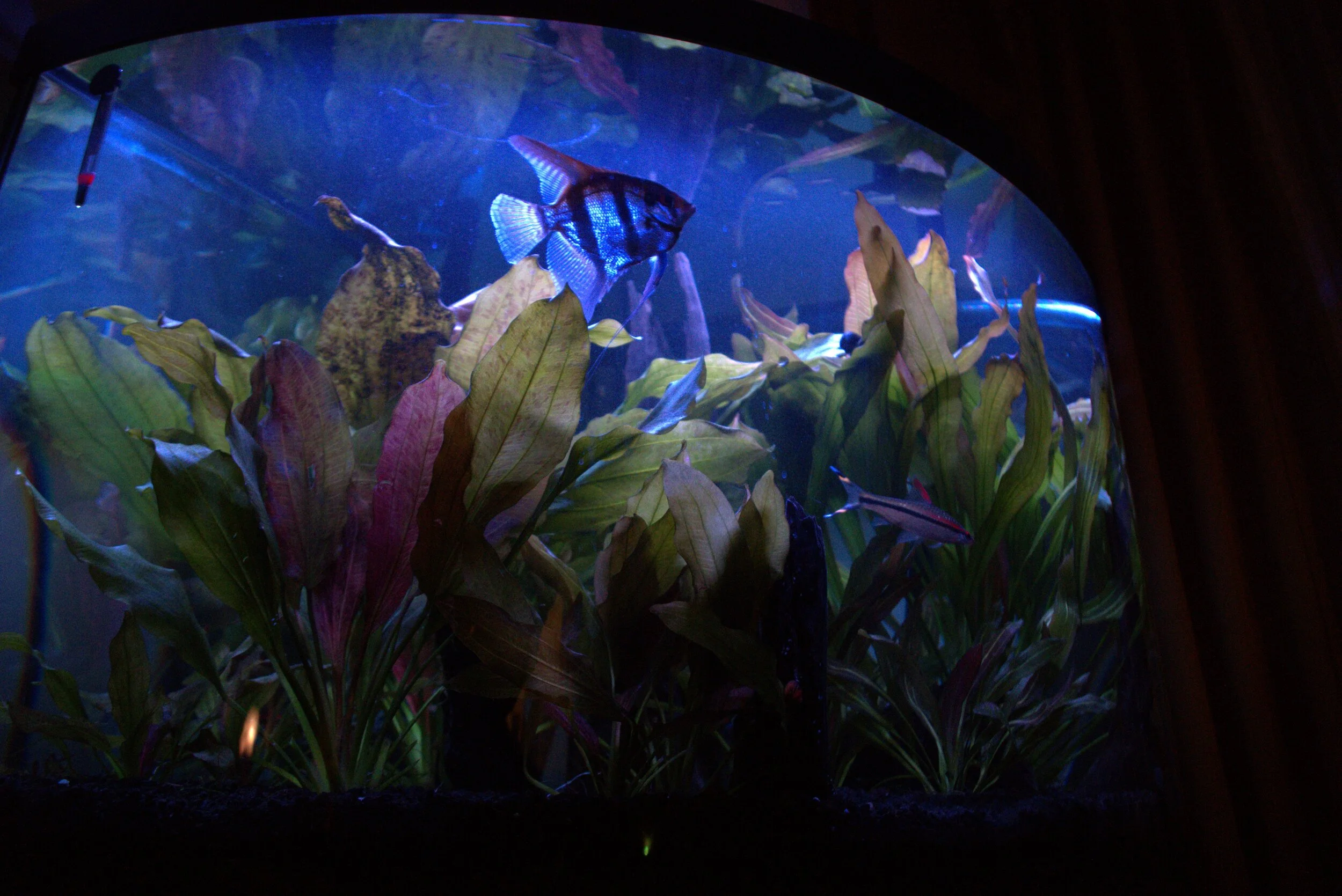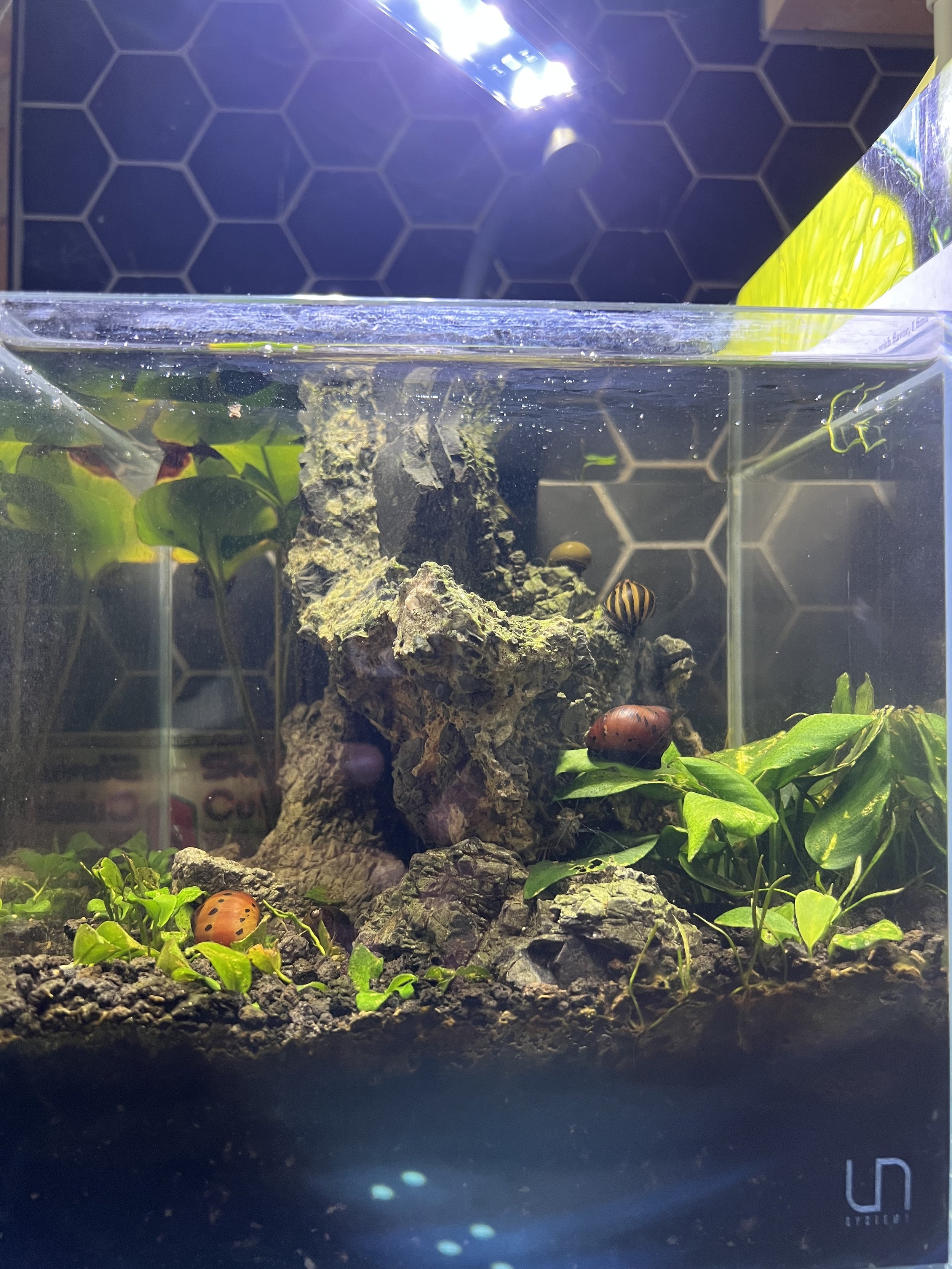
A Lesson in Sustainability
Taught by the fishes of 2 Norbridge Drive
Overview
Objective // To alleviate key pain point of aquarium owner (me) around tank maintenance, while ensuring quality accommodations for aquatic inhabitants.
Roles // Ecosystem engineer, aquarium interior design, fish therapist
Collaborations // Neighborhood pet store, Google
Situation
With my mom “allergic” to most domesticated beings you’d find in your neighborhood PetSmart, the only palatable pet option that I had growing up were fish. They were cool, but there’s only so much swimming you can watch. Nonetheless, I took what I could and maintained an aquarium from elementary school onwards.
A little after graduating from Illinois, I remember one day where I sat down next to the tank to while away a couple minutes. But this time I saw things a little differently.
I saw a synthetic world. Bored helpless inhabitants, living a subsistence life with occasional territorial spats. Plastic plants, covered by algae that never quite seemed to go away. Unnaturally vibrant gravel. Even the plaster dragons that breathe out bubbles every so often seemed bored. I hated the idea that this was the life I had created for these living beings.
Outcome
What I built is a pretty realistic biotope of a South American riverbed.
I bought a larger tank, as it’s typically easier to establish ecosystems with more water, and I ditched anything that wasn’t a product of Nature’s design efforts over the millennia.
Black volcanic rock constituted the tank bed; with the countless divots, the rock lends itself very useful to fostering micro cultures to fuel the system.
Live plants oxygenate the waters and use waste from the tank’s inhabitants as natural fertilizer to grow.
I added snails to help break down excess food, waste, and decaying plant matter into a form more palatable for the plants.
Fish are the happy citizens, fueling the system.
Today, you can see a clear difference in routine and environment. Maintenance required of the tank is significantly less as the system handles most of waste and cleaning. There’s also a very clear difference in fish behavior, with more liveliness and personality in their movements.

The Recyclers
I evaluated the fish I had at the time, which were two mature angelfish, and complemented these two with schools of smaller fish to graze and take care of any excess or smaller food particles.
The fish were all tropical freshwater fish from the Amazonian region, with the exception of a Yo-Yo Loach that I added to combat an overpopulation of Malaysian trumpet snails.

The Reducers
As a cleaning crew, I invested in two types of snails - Nerite and Malaysian Trumpet snails. Nerite snails are famous in the aquascaping community for being voracious algae eaters. Basically self-sustained little roombas that don’t stop moving.
Trumpet snails have a mixed reputation, due to their tendency to exponentially multiply in the presence of excess waste, but are ideal for breaking down leftover food and plant material.
This photo is actually from another much smaller, 1-gallon tank I set up; I couldn’t find a good one of the snails from my archives. This one has an Japanese Amano shrimp lurking under a leaf, another legendary “reducer” in the aquascaping world, although equally as temperamental to take care of.

The Reusers
All plants I selected were Swords that originate from the Amazonian ecosystem, chosen for their hardiness and ease of growing. I figured I’d have to go through a couple prototypes to establish the system, so I opted for plants that would be more likely to have patience in dealing with my experiments.
True Test of Happiness
Fish are quite picky about the conditions of their environment when they’re looking to lay a batch of eggs. It was quite magical watching this age-old mating ritual of angelfish happen in my tank, because the pair felt safe enough with respect to stability of water conditions and environment.
They probably laid 4 or 5 batches of eggs across their prime years. Due to the finite community environment of the tank, eggs / fry were either lost to the other tank inhabitants or to the parents themselves, who have an instinct to recoup energy losses (through calories) if they detect risk to the livelihood of their fry.
Key Takeaways
Value of a System-Based Approach
This experiment would not have been successful without an analytical exercise upfront of identifying the key variables and levers for adjusting. Nature itself is a system, so if I wanted to recreate its sustainability, I needed to approach it as such.
Viewing the system as a circular system gave me a framework with which to fill in quantity of ingredients (I.e. the aquarium’s inhabitants).
Parallels between Natural & Synthetic Systems
I found it very interesting how I could analogize a process on as small a scale as my fish tank to how Earth handles of her respective populations. The realization was quite inspirational, and motivated my foray into the world of sustainable design.
The Intricacy of Nature
Through a thorough process of trial & error, mutation, and adaptation, Nature’s systems are the perfect sustainable balance. Reaching homeostasis in the tank required calculation, patience, and observation - which allowed me a delightful glimpse into how intelligently aquatic flora and fauna interact with their environment to thrive.